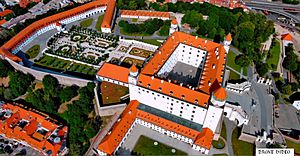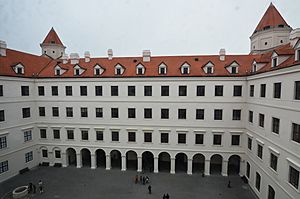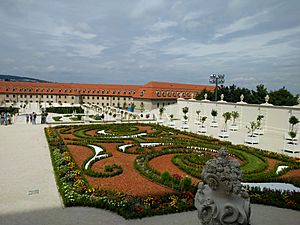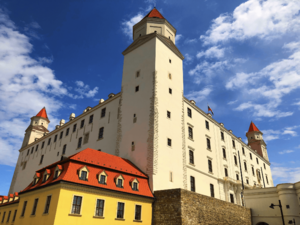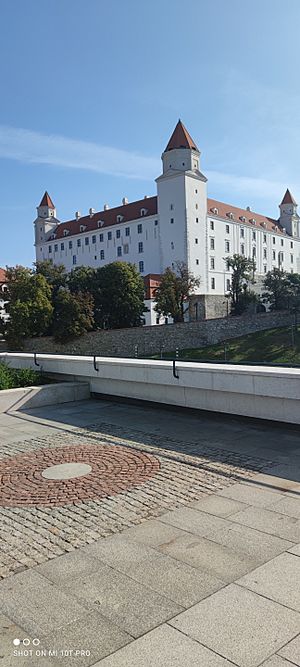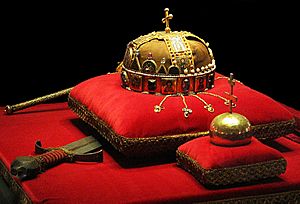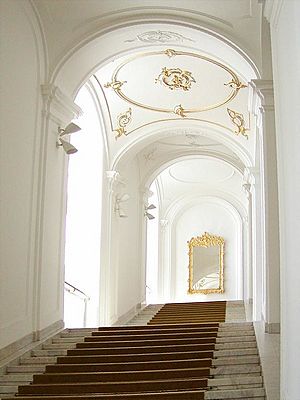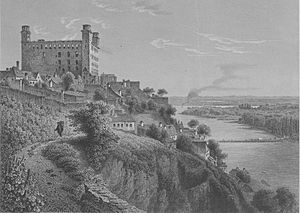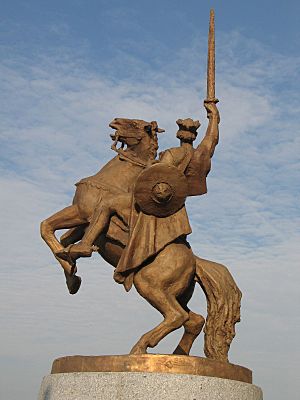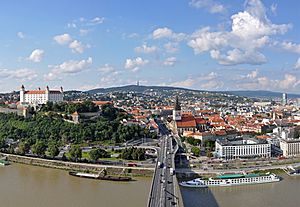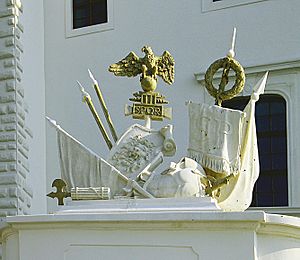Bratislava Castle facts for kids
Quick facts for kids Bratislava CastleBratislavský hrad |
|
|---|---|
| Bratislava Slovakia |
|
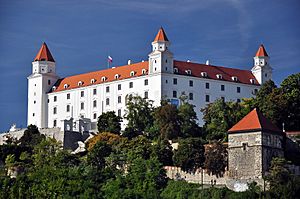
Bratislava castle
|
|
| Type | Castle |
| Site information | |
| Controlled by | Great Moravia, Kingdom of Hungary, Czechoslovakia, Slovakia |
| Open to the public |
outdoor areas nonstop, opening hours apply to the museum |
| Condition | Under reconstruction |
| Site history | |
| Built | 9th century – 18th century Rebuilt in 1956-1964 |
| Events | Notable events in the castle's life:
|
Bratislava Castle (Slovak: Bratislavský hrad) is the main castle of Bratislava. Bratislava is the capital city of Slovakia. This huge rectangular building has four towers at its corners. It stands on a rocky hill of the Little Carpathians. The castle is right above the Danube river. Its large size and location have made it a famous landmark for hundreds of years.
From the castle, you can see great views of Bratislava and Austria. On clear days, you can even see parts of Hungary. Many old stories and legends are connected to the castle's long history.
Contents
- What can you find at Bratislava Castle?
- History of Bratislava Castle
- See also
What can you find at Bratislava Castle?
The Castle Building (The Palace)
The main castle building has four towers, one at each corner. There is also a courtyard with a deep water well. This well is about 80 meters (262 feet) deep. The biggest and tallest tower is the Crown Tower. It is on the southwest corner. This tower is 47 meters (154 feet) tall and was built in the 13th century. For about 200 years, starting in the mid-1500s, it held the crown jewels of Hungary.
The outer walls and inside hallways still show parts of old Gothic and Renaissance designs. You can still see a walled-up entrance gate from the 16th century. It is to the east of the main entrance.
Museum
Inside the castle, a hallway leads to a big Baroque staircase. This staircase takes you to the second floor. Here, you can find exhibitions from the Slovak National Museum. The west side of this floor has four rooms called the Treasure Chamber. These rooms opened in 1988. They show a collection of Slovakia's most valuable old finds. This includes a prehistoric statue called the Venus of Moravany.
The third floor has an exhibition about the History of Slovakia. On the first floor, in the south part of the building, are the rooms of the Slovak parliament. This is called the National Council of the Slovak Republic. These rooms have furniture from the 16th century. The north part of the building used to be a Baroque chapel. Now, it is the Music Hall, where concerts are held. The courtyard has an entrance to the Knights Hall.
Entrance Gates
- Sigismund Gate: This gate is in the southeast. It is the best-preserved original part of the castle site. It was built in the 15th century.
- Vienna Gate: This gate is in the southwest. It was built in 1712.
- Nicholas Gate: This gate is in the northeast. It was built in the 16th century.
- Leopold Gate
Other Buildings
To the west of the main castle building, you will find the newly rebuilt F. A. Hillebrandt building. It was built in 1762 but was destroyed by the fire in 1811. The Yard of Honor is the area right in front of the castle entrance. It was built in the late 18th century.
Inside the Sigismund Gate and below the Court of Honor is the Leopold Yard. This yard has strong walls called bastions. They were built in the 17th century. To the east of the castle building, you can see outlines on the ground. These show where the Great Moravian basilica (from the 9th century) and the Church of St Savior (from the 11th century) once stood. The real old findings are buried right below these outlines.
Next to the Nicholas Gate, a Gothic gateway from the 15th century, is the Lugiland Bastion. This is a long, three-floor building from the 17th century. Today, it houses the National Council of the Slovak Republic. There is also a Baroque stable nearby, which is now a famous restaurant. A French baroque garden is located south of the stable.
The northern edge of the castle site has a long Baroque building from the 18th century. This building now holds the Slovak National Museum and the castle's offices.
History of Bratislava Castle
Early Times (2800 BC – 5th Century AD)
The castle hill, like the city today, has been lived on for thousands of years. It is in a very important spot in the middle of Europe. It sits where the Carpathians and the Alps meet. It is also near a place where people could easily cross the Danube river. Many old trade routes, like the Amber Route, also crossed here.
The first people known to build settlements on the castle hill were from the Boleráz culture. This was around 3500 BC. Their "castle" was a strong, fortified settlement. It was like a high city, or acropolis, for other settlements in what is now Bratislava's Old Town.
Later, during the Hallstatt Period (Early Iron Age, 750 – 450 BC), people built a structure into the rock of the castle hill. Again, this "castle" served as an acropolis for nearby settlements.
During the Celtic Period (Late Iron Age, 450 BC – 1 BC), the castle hill became a very important Celtic center. In the last century BC, it was the acropolis of a Celtic town called an oppidum. Many different items, like coins and parts of Roman buildings, have been found here. This shows how important it was.
The castle hill was on the Danube river, which became the border of the Roman Empire in 9 BC. Romans also lived here from the 1st to 4th centuries AD. We know this from findings like bricks from Roman legions and parts of Roman buildings. What happened in the 5th century, during the time of big migrations, is not very clear.
Slavs and Great Moravia (500 – 907)
When the Slavs arrived in the Bratislava area, they first used old Roman and Celtic structures. They also added some new defenses. Around the late 8th or early 9th century, during the time of the Principality of Nitra, a Slavic castle was built. It had wooden walls and covered a huge area of 55,000 square meters.
In the second half of the 9th century, during Great Moravia, a stone palace was added. It was surrounded by homes and a large basilica (a type of church). This basilica is the biggest Great Moravian basilica found in Slovakia. The castle area was about the same size as the important Great Moravian site of Mikulčice.
Old Roman building materials were used to build this Slavic castle. Some historians believe that around 805, a Great Moravian prince named Uratislaus built Bratislava Castle. The castle and town might have been named after him. The oldest name for the castle was Preslava (Slovak) or Preslav(a) sburg (German). This name first appeared in 907 during the Battle of Pressburg.
Middle Ages (907 – 1531)
Building a new stone castle began in the 10th century, but it took a long time. Under King Stephen I of Hungary (1000–1038), the castle was already one of the main castles of the Kingdom of Hungary. It became the center of Pozsony county. It helped protect the kingdom from attacks by Czech and German forces. The castle also played a big role in fights over who would be king of Hungary.
In 1052, Emperor Henry III tried to take the castle. A Hungarian soldier named Zothmund swam to the enemy ships and made holes in them, sinking them. The old wooden walls were improved, and a church and school were added.
In the 12th century, the castle was rebuilt into a proto-Romanesque palace of stone. This was similar to palaces built in Germany. In 1182, Friedrich Barbarossa gathered his crusader army near the castle. The church buildings at the castle were moved to the town below in the early 12th century.
Bratislava Castle was one of the few castles in Hungary that could survive the Mongol attacks in 1241 and 1242. After these attacks, a huge "tower for the protection of the kingdom" was built at the castle in 1245. This tower was a very tall residential building. Also, seven square towers were added to the old walls. A stone wall was built around the main castle building. The biggest of these new towers is now part of the castle building. It is the present-day "Crown Tower." It was probably built around 1250.
The castle faced more fights. In 1271, the Czech King Otakar II of Bohemia took over the area. Later, in 1285-86, a noble named Nicholas I Kőszegi took the castle to start a rebellion. But he was defeated. From 1287 to 1291, the Austrian duke Albert of Habsburg also occupied the castle but was defeated.
Because of these constant fights, the Hungarian king gave city rights to some settlements below the castle in 1291. This took them out of the castle's control. Some settlements on the castle hill stayed under the castle's authority. The defenses were slowly extended to protect them.
In 1385, King Sigismund of Luxembourg took over the castle. He later used it as a guarantee for a loan. The castle was taken back in 1389 by Stibor of Stiboricz. He was rewarded by becoming the head of Pozsony county. He also had a chapel built in Bratislava Castle.

King Sigismund, who was also the Holy Roman Emperor, decided to make Bratislava Castle the center of his new empire. This was because of its central location. In 1423, the king ordered the castle's defenses to be improved against attacks. They replaced the old wooden walls with strong stone ones. Then, from 1431 to 1434, the castle was completely rebuilt. Experts from Germany were brought in. Materials came from Austria. Towns had to pay special taxes for this huge building project. The new Gothic palace looked much like the castle today. The Sigismund Gate is the only fully preserved part from this time. King Sigismund never lived in the castle, he lived in the town below.
After Sigismund died in 1437, his wife Barbara of Celje was held prisoner in the castle. In 1438, his daughter Anne got engaged in the castle. Later, Ladislas the Posthumous probably lived here. There were also fights between the castle and the town from 1440-1443. A water well was built in the castle yard in the 15th century.
Main Castle of the Kingdom of Hungary (1531 – 1783)
Political Events
In 1536, after the Turks (the Ottoman Empire) took over parts of Hungary, Pressburg became the capital of the remaining Kingdom of Hungary. This part was called Royal Hungary and was ruled by the Austrian Habsburgs. So, Bratislava Castle became the most important royal castle. It was the official home of the kings of Royal Hungary, even though they usually lived in Vienna.
From the early 16th century, Bratislava and its castle faced many uprisings against the Habsburg rulers. For example, troops led by Gabriel Bethlen took over the castle from 1619 to 1621. The royal crown was even moved from the castle for a time. Between 1671 and 1677, the castle was used for special trials against Protestants and rebels. Imre Thököly, another rebel leader, tried to take the castle in 1682-83 but failed.
Holy Crown of Hungary in the Crown Tower
Between 1552 and 1784, the Holy Crown of Hungary was kept in the castle. Two Hungarian crown guards and 100 soldiers protected it. Kings from other families, like the Habsburgs, could not own the crown. They only had access to it during their coronation ceremony.
The Renaissance Makeover
After the Hungarian king died in a battle in 1526, the queen, Maria of Habsburg, fled to Pressburg. She brought the royal treasure with her, including valuable art and royal items. This treasure was stored in Bratislava Castle. However, much of it was later destroyed by the new king, Ferdinand I. He needed money to fight a civil war.
Because of the castle's new important role, Emperor Ferdinand I had it rebuilt. Italian builders and artists worked on it from 1552 to 1562. The main architect was Pietro Ferrabosco. The castle's shape did not change much, but the inside and outside were completely redone. Floors and rooms were rearranged, and most rooms got beautiful, expensive decorations. Later, a ball house and a new water well were added. Only a small part of the castle chapel from this time is still preserved.
After 1530, the castle housed important people attending meetings of the Diet (parliament). It also held some central government offices and the apartment of the Governor of Royal Hungary. Since 1552, the crown jewels were kept in the Crown Tower. Important Diet meetings also took place at the castle.
Baroque Changes
Early Baroque
Some of the Renaissance changes were done quickly, especially the wooden roof. So, in 1616, a new, gradual Early Baroque reconstruction began. This work was based on designs by Giovanni Battista Carlone. It became more intense in 1635 and finished around 1647. Count Paul Pálffy, the castle captain, mostly paid for it. The castle's look from this time is mostly what we see today.
The northern and western parts of the main building were newly built. A new, third floor was added to the whole building. The main entrance was moved back to the middle of the wall. The old defenses were improved. The chapel was moved from the south to the north side (now the Musical Hall). Two new towers were added, making the total four towers at the corners. In 1650, Count Paul Pálffy was made lifelong captain of Bratislava Castle. This was a reward for managing the building work well.
In 1653, all the wooden ceilings were found to be bad and had to be replaced. This meant that valuable paintings on them were lost. Ten years later, facing Turkish attacks, the defenses were improved again. More improvements followed around 1673. These ended when the Turks were finally defeated in Vienna in 1683. In 1703, soldiers' barracks were built. The present-day Vienna Gate was built in 1712 for the coronation of Emperor Charles VI. It became the main entrance to the castle site.
The Maria Theresa Changes
When Maria Theresa of Austria became queen of the Kingdom of Hungary in 1740, she promised to have a home in both Austria and Hungary. She kept her promise and spent a lot of time at Pressburg Castle. So, the castle was changed from a defense castle into a modern royal home. This happened between 1761 and 1766.
Smaller changes started as early as 1740. A large garden was added to the north. Emperor Francis I, Maria Theresa's husband, created a small garden to the east. The main designer until 1757 was J. B. Martinelli.
Major changes inside the castle, in the rococo style, began in 1760. The new main designer from 1761 to 1762 was Franz Anton Hillebrandt. A new building for the kitchen, servants, and horses was added to the western wall. The castle needed more water, so Maria Theresa had Johann Wolfgang von Kempelen build a special water pipe. It used pumps to bring water from the Danube river. The stairs in the castle were rebuilt with a gentler slope. Maria Theresa wanted to be able to ride her horse up them. The outside of the palace and the gates ended up looking very much like Bratislava Castle today.
Maria Theresa appointed a governor for the Kingdom of Hungary in 1765. This governor obeyed the queen. Bratislava Castle became his home. The second governor was Albert of Saxe-Teschen, Maria Theresa's son-in-law. Albert and his wife, Marie Christine of Austria, moved to the castle in 1766. They loved culture and science. So, the castle and town became a place for many cultural and scientific events.
The governor needed more space. So, a new palace called the Theresianum was built next to the eastern wall of the castle building. This was from 1767 to 1770. It was designed by F. A. Hillebrandt in the classic style. Its furnishings were very expensive. The first floor had a family art gallery. This gallery later became the start of today's Albertina Gallery in Vienna.
Also, a winter riding school was added to the north of the castle. A summer riding school was in the castle yard. Both castle gardens were redesigned. For the first time, the road to the castle had night lighting using oil lamps. In 1770, Maria Theresa ordered more valuable paintings and furniture for the castle and the Theresianum. The governor moved into the completed Theresianum. Maria Theresa often visited them there.
Loss of Importance and Destruction (1783 – 1811)
The job of governor of the Kingdom of Hungary was ended in 1781 by the new king, Joseph II. Albert of Sachsen-Teschen left the castle and took many of the furnishings with him. The art collection went partly to Vienna and partly to Belgium. Other items mostly went to Vienna. In 1783, Pressburg was no longer the center of the kingdom's government. These offices moved to Buda (now Budapest). The crown jewels of Hungary were moved to the Hofburg in Vienna.
In 1784, the Theresianum and other castle buildings were changed. The castle became a "general seminary." This was a state school for Catholic priests started by Joseph II. The general seminary at Bratislava Castle was very important for Slovakia's history. Many important Slovak thinkers studied there. One was Anton Bernolák, who created the first successful standard Slovak language.
In 1802, the general seminary moved. The castle was then given to the military to be used as barracks. This was the beginning of the end for the castle. The beautiful rococo interiors were changed to house about 1500 soldiers. In 1809, Napoleon's troops attacked Pressburg and the castle with cannons. On May 28, 1811, the castle caught fire. This happened because soldiers were careless. The fire was huge and even spread to parts of the town.
Castle in Ruins (1811 – 1953)
The destroyed castle slowly fell apart. The military sold parts of the main castle buildings as materials for other constructions. Between the two world wars, there were ideas to tear down the castle. Some wanted to build government offices and a university area on the castle hill.
However, many parts of the site continued to be used as barracks until 1946. In 1946, the castle ruins were opened to the public. Two years later, the town built an amphitheater in the northern part of the castle site. This amphitheater was used for about 15 years. Films were shown there in the summer.
Restoration and Modern History (after 1953)
Finally, it was decided to restore the castle. Experts started researching the castle's history and architecture in 1953. Long restoration works began in 1957. The main building was restored to how it looked in its last Baroque period. But in many places, older parts from Gothic and Renaissance times were also restored. The Theresianum was not restored. The F. A. Hillebrandt building from 1762 was restored around the year 2000. The Slovak painter Janko Alexy was praised for his work on the castle's restoration.
The restoration was almost finished in August 1968. But then, the castle was taken over by Warsaw Pact troops. However, on October 28, 1968, an important law was signed in the Federation Hall of the castle. This law changed Czechoslovakia into a federation of the Czech and Slovak Republics. On September 3, 1992, the new constitution of independent Slovakia was signed in the Knights Hall of the castle.
Since 1968, the castle has housed exhibitions of the Slovak National Museum. Its rooms are also used by the National Council of the Slovak Republic for special events. In 1992, the castle temporarily held an office for the Czechoslovak president. Later, in the 1990s, it temporarily housed the Slovak president. Today, it still has the museum and rooms for the National Council and the president.
A big reconstruction started in 2008. It was planned to take five years. On June 6, 2010, the reconstruction of the Honorary Courtyard was finished. A large statue of King Svätopluk I by sculptor Ján Kulich was unveiled there.
See also
 In Spanish: Castillo de Bratislava para niños
In Spanish: Castillo de Bratislava para niños


